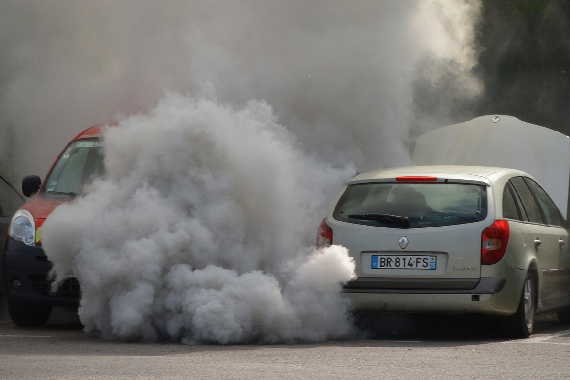According to World Health Organization calculations, more than four million premature deaths occur as a result of exposure to ambient (outdoor) air pollution every year. Without a doubt, improving air quality, particularly in cities, should be a priority. On December 2019, the UN General Assembly declared September 7 International Day of Clean Air for blue skies to raise awareness about the risk that air pollution poses for human health and the climate.
According to the WHO, it is pivotal for domestic and international public organizations to become involved in identifying the activities that cause air pollution and fostering the development of cleaner alternatives, since most of these sources are beyond the control of individual citizens.
Air-polluting substances
In 2005, the WHO published the latest update of its air quality guidelines (the next update is scheduled in 2020), intended to offer guidance in reducing the health impacts of air pollution. The 2005 update contained new information related to four common air pollutants, including recommendations for maximum concentration levels over which they are considered to pose a health hazard. These substances were:
- Particulate matter: Particulate matter (PM) is a mixture of solid or liquid particles suspended in the air whose common constituents include sulfates, nitrates, ammonia, sodium chloride, soot or mineral dust. While particles vary in size, it is the smallest ones that are most hazardous to human health. In a series of videos posted by the World Health Organization on its website to communicate the work and experience of air pollution experts, Lidia Morawska, Director of the International Laboratory for Air Quality and Health, explains that, unlike larger particles, visible to the human eye, nanoparticles do not get stuck in the nostrils. For this reason, they can penetrate into the deep parts of the lung, and there it can cause inflammation, or it can penetrate the pulmonary barrier into the bloodstream, consequently altering blood properties and causing respiratory and cardiovascular problems.
- Ozone: Unlike stratospheric ozone, which protects humans from the sun’s ultraviolet radiation, ozone present at ground level is detrimental to human health. Ozone is formed by photochemical reactions in the presence of sunlight and precursor pollutants, such as oxides of nitrogen from vehicle exhausts, solvents and industrial activities. As ozone concentrations increase above guideline values, impact on human health becomes increasingly hazardous, leading in some cases to respiratory issues and pulmonary diseases.

- Nitrogen dioxide (NO2): According to WHO, the major source of anthropogenic emissions of nitrogen oxides into the atmosphere is the combustion of fossil fuels in stationary sources (heating, power) and in vehicle and boat engines. It can cause inflammation of the airways, bronchitis and even reduced lung development.
- Sulfur dioxide (SO2): Sulfur dioxide is a colorless gas that has an extremely characteristic pungent smell, which is derived from “the combustion of sulfur-containing fossil fuels for domestic heating and for power generation.” Like the previous compounds in this list, this substance can cause respiratory and lung problems, as well as eye irritation. In addition, if combined with water and air it can form sulfuric acid, causing the so-called “acid rain” phenomenon, which has harmful impacts on flora and fauna and a causes deforestation.
Cities: Bearing the brunt of air pollution
The impact of the aforementioned substances on human health is especially significant in cities. Although it is difficult to determine which are the world’s most polluted cities due to the lack of accurate measurements using the same criteria globally, according to the WHO several Asian cities – Karachi, New Delhi, Kathmandu and Beijing – have very high pollution levels. The organization also cites Lima and Arequipa in South America, and Cairo, in Africa.
However, it also stresses that substantial health effects can be seen even in the relative cleaner cities of Europe or North America, where PM levels are 3-5 times lower than in the most polluted cities.

To improve air quality in cities, the UN has proposed a series of measures which include the adoption of clean technologies in all possible sectors (industry, transport, energy, electricity generation), better urban planning to improve energy efficiency and more efficient waste management to minimize the need to incinerate solid waste, which creates polluting gases.
Household air pollution
In addition to outdoor air pollution, efforts must also be made to minimize household indoor air pollution, as it can also have detrimental impacts on human health.
According to WHO estimates, about 3 billion people across the planet still use solid fuels, that is, wood, crop residues, coal and dung, to cook and heat their homes. These fuels produce high levels of household air pollution. In poorly ventilated dwellings, indoor smoke can be 100 times higher than acceptable levels for fine particles. Exposure is particularly high among women and young children, who spend the most time near the domestic hearth.

The consequences are devastating. According to 2012, 3.8 million people a year die prematurely as a result of illnesses caused by household air pollution derived from the inefficient use of solid fuels for cooking. These illnesses include pneumonia, stroke, ischaemic heart disease, obstructive pulmonary disease and lung cancer.
Kerosene lamps are another source of indoor air pollution. Many of the 1.2 billion people that still use these lamps across the world without access to electricity.
Quality of the air in the Sustainable Development Goals
The UN Sustainable Development Agenda 2030 includes improving air quality as a key element to fulfilling the Sustainable Development Goals, a list which consists of 17 goals – each with specific targets – considered essential for improving the lives and prospects of everyone, everywhere.
The reduction of hazardous air pollutants is crucial to achieve some of the specific targets defined for several goals, including SDG 3 (health and well-being), 7 (affordable and clean energy), 11 (sustainable cities and communities) or 13 (action for climate).
Comments on this publication